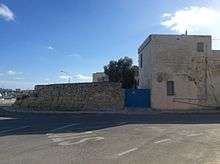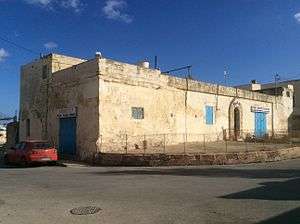Pinto Battery
| Pinto Battery | |
|---|---|
| Batterija ta' Pinto | |
| Birżebbuġa, Malta | |
|
Pinto Battery's blockhouse | |
| Coordinates | 35°49′36″N 14°31′58.5″E / 35.82667°N 14.532917°E |
| Type | Artillery battery |
| Site information | |
| Owner | Government of Malta |
| Controlled by | Private tenants |
| Open to the public | No |
| Condition | Blockhouse intact but heavily altered, gun platform largely destroyed |
| Site history | |
| Built | 1715–1716 |
| Built by | Order of Saint John |
| Materials | Limestone |
Pinto Battery (Maltese: Batterija ta' Pinto), also known as Għżira Battery (Maltese: Batterija ta' Għżira) or Kechakara Battery,[1] is a former artillery battery in Birżebbuġa, Malta. It was built by the Order of Saint John between 1715 and 1716 as one of a series of coastal fortifications around the coasts of the Maltese Islands. The battery has been heavily altered over time, and the blockhouse now houses a bar and a garage, while the gun platform and parapet have been largely destroyed, with only the general outline still visible.
History


Pinto Battery was built in 1715-1716 as part of the first building programme of coastal batteries in Malta. It was part of a chain of fortifications that defended Marsaxlokk Bay, which also included six other batteries, the large Saint Lucian Tower, two smaller De Redin towers, four redoubts and three entrenchments.[2] Construction of the battery cost 1109 scudi.[3]
The battery originally consisted of a semi-circular gun platform, with a parapet containing eight embrasures. Its gorge had a large rectangular blockhouse protected by a redan. The battery's entrance was located within the redan.[4]
Present day


The battery has undergone major alterations over time, being largely destroyed in the process. The redan has been destroyed, while the blockhouse is a bar and a garage. The general outline of the semi-circular gun platform can still be seen, although the parapet with embrasures no longer exists.[4]
References
- ↑ Farrugia Randon, Stanley (2015). Heritage Saved – Din l-Art Ħelwa – 1965–2015. Luqa: Miller Distributors Ltd. p. 119. ISBN 9789995752132.
- ↑ "Vendôme Tower" (PDF). Mare Nostrum. Retrieved 25 June 2015.
- ↑ Spiteri, Stephen C. (18 October 2010). "St. Thomas Tower and Battery". MilitaryArchitecture.com. Retrieved 25 June 2015.
- 1 2 "Għzira Battery" (PDF). National Inventory of the Cultural Property of the Maltese Islands. 28 June 2013. Retrieved 13 August 2015.
